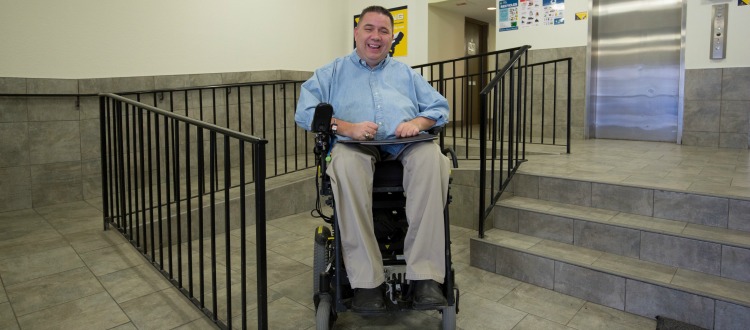
Barry Lindemann, who has been in a wheelchair since 1994, says there is a lack of barrier-free homes in Calgary.
March 21, 2016 | Paula Trotter
The pursuit of barrier-free living
Accessibility advocates call for mandatory universal design to be part of Alberta Building CodeBarry Lindemann jokes that he can tell how much his friends like him by the number of steps they have leading up to their front door.
The born-and-raised Calgarian has been in a wheelchair since 1994 when he suffered a spinal cord injury after a diving accident at Buck Lake in central Alberta. He was 22.
"I never did get to see my bedroom again because it was downstairs," he said. "It's just the way of life where stairs are the enemy. You want to go about doing the same things you use to, but it seems like there are hurdles everywhere."
As a young adult who was determined to live a full, independent life, Lindemann was fortunate to get one of the handful of barrier-free suites at Chinook House, a residential property run by the non-profit Accessible Housing.
It's still his home 21 years later.
"No one has moved from my building in almost 10 years," said Lindemann, explaining there is a lack of barrier-free homes in Calgary. "I visit new injuries at the hospital, and people are in there for six months to a year because there are no suitable living situations.
"We don't have to recreate the wheel. If you're going to build housing, build in accessibility."
Having affordable, accessible housing is a pillar of universal design, which is the creation of spaces that can be used by all people, regardless of their abilities.
The Alberta Building Code, however, does not require developers to design barrier-free homes or condos unless they are provincially or federally funded.
The City of Calgary created its Universal Design Handbook in 2010 to "encourage" developers to go above and beyond the Alberta Building Code to create spaces that are accessible for all abilities.
"We felt from an education and knowledge perspective, it was good to have this information available for professionals when they're designing anything," says Leanne Squair, issue strategist, accessibility, for the City of Calary who helped create the handbook. "But as a city, we can only control what we own and operate – we can't control what the external industry does."
Squair hopes developers soon follow the lead of builders such as Stepper Custom Homes on a larger scale. Stepper received the Access Recognition Award from the City of Calgary's advisory committee on accessibility in 2012 for building the city's first "visitable" home – complete with level entryways, a zero-entry shower and wider doorways and hallways, all of which are universal design best practices.
"Everyone has always thought of us a young city, but we're aging and with that comes age-related disability – you need universal design to accommodate that,"
Squair said visitable homes will appeal to more than individuals with disabilities, such as limited mobility; they'll also appeal to couples who have aging parents living with them or young families who want to age in place.
And there will be a drastic need for barrier-free homes in the near future as the senior population in Calgary is expected to triple by 2030.
"Everyone has always thought of us a young city, but we're aging and with that comes age-related disability – you need universal design to accommodate that," said Squair.
Barrier-free public spaces
Of course, universal design isn't limited to residential properties. The creation of inclusive public spaces is equally as important, said Squair – an area the City does have control over.
All City-owned and operated spaces must adhere to the municipality's Access Design Standards, which Squair said goes beyond the Alberta Building Code, particularly in the areas of sensory and hearing disabilities.
This past summer, council also approved Coun. Druh Farrell's motion to audit all City-owned buildings to determine which ones need to be retrofitted to improve accessibility.
Education key to improvement
While the City is making progress in designing usable public spaces for people of all abilities, Lindemann and other advocates for the disabled agree there is always room for improvement.
"We ask for all this stuff, but we have to educate the reason why it helps," said Deb Bignell, orientation and mobility specialist with CNIB.
Bignell teaches blind and partially sighted individuals how to get around safely. She would like to see universal design best practices become part of the Alberta Building Code, and universal design course be mandatory for architect and interior design students.
"A lot of people think accessibility just looks ugly, but you can make something look good and have it be accessible," she said.
Tagged: Calgary Community | Calgary Real Estate News




